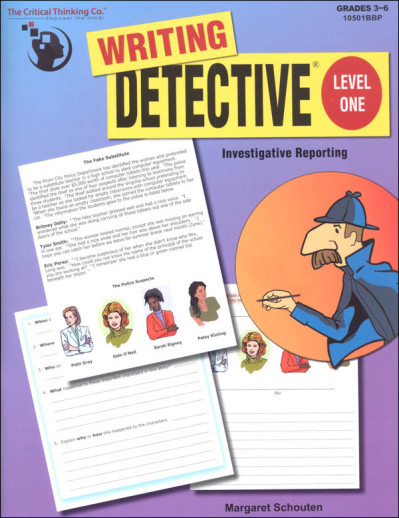We use cookies to make your experience better. To comply with the new e-Privacy directive, we need to ask for your consent to set the cookies. Learn more.
Writing Detective - Level One
If you believe you need to think clearly to write so readers can understand what you have written, you'll find that Writing Detective® is a very helpful set of supplemental writing activities.
In Writing Detective®, students in Grades 3-6 act as investigative reporters writing articles for a local newspaper. To write the article, students must use higher-order thinking skills to synthesize clues they identify in the story to solve the mystery. Every activity requires students to put clues together and then evaluate the evidence to infer or deduce what happened in the story. The stories are high interest to make it easy to motivate students to do the analytical work needed to piece together the evidence and write the article.
Before writing, students complete an outline detailing When, Who, What, Where, and How or Why. These fun, easy-to-use activities develop reading comprehension, higher-order thinking, and writing and organization skills. Answers for the Reading Comprehension questions and Outlines as well as Article sample answers are provided. There is a simple scoring rubric to make grading easier.
These materials cover various types of informational writing, includingpersuasive writing, essays, outlines, and research papers.
This program shares everything students need to know to publish materials for their high school. It is not always homeschool friendly, as it mostly gives instruction on how best to report on school news in newspapers and yearbooks. The text is geared to teach whole staffs of student writers to develop specific publications and assumes that students are at schools with computers, software programs, photographers, and many classmates, sporting events, and clubs to report on. That being said, some of the content can be modified and the basics of good journalistic writing are laid out very well. A concise history of journalism is covered and students get instruction on good writing, the laws of journalism, ethics, how to layout pages and format, editing, and pretty much every other aspect of journalism, especially as it relates to newspapers and yearbooks. It discusses the duties of a journalist, styles of writing, parts of a newspaper, design, photography, and a variety of careers in the field. As a college journalism major, I can see the same methods and much of the same information I was taught at college in this program. If you have a student who is interested in journalism, this would be useful curriculum to look at, though it is more school-oriented and a few of the exercises would be more difficult to complete. For instance, several exercises instruct students to look at last year's edition of the yearbook or the last issue of the school paper and analyze certain aspects of journalism and make changes or write a report on what is found. These exercises could be done using newspapers, but it would be more difficult to find examples of what the text is focusing on. Also, students are often asked to analyze their schools editorial, news, and advertising policies. The text itself is very informative, and though it uses examples from school publications, it often focuses on journalism as a whole and teaches terms, jargon, formats, and procedures that are vital for success in the field. The text has eighteen chapters: History of American Journalism, Rights and Responsibilities, Style and Editing, News, Sports, Feature, Editorial, Column, and Headline Writing, Yearbook Copy, Broadcast Journalism, Digital Age, Newspaper Design, Yearbook Design, Caption Writing, Advertising, Photography, and Careers in Journalism. Each chapter is full of instruction, guidelines, tips, examples, and history and is followed by a list of exercises dealing with the topic. The Student Workbook provides worksheets for each chapter, sometimes including a summary of the chapter. These worksheets include fill-in-the-blank questions from the text and prompts for writing news stories. There are editing exercises and even practice in laying out stories for a newspaper or yearbook. Some of the chapters have many pages of worksheets and some have just a few, depending on the complexity of the issue. The Teacher Guide is the same as the Student Workbook, but with answers. Overall, this curriculum does a great job of teaching the basics of journalism and covers almost everything needed to publish a junior high/high school newspaper or yearbook. ~ Rachel S.
| Product Format: | Paperback |
|---|---|
| Brand: | Critical Thinking Company |
| Grades: | 3-6 |
| ISBN: | 9781601446497 |
| Length in Inches: | 11 |
| Width in Inches: | 8.5 |
| Height in Inches: | 0.375 |
| Weight in Pounds: | 0.5 |

